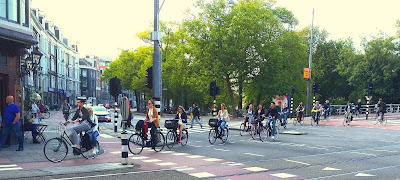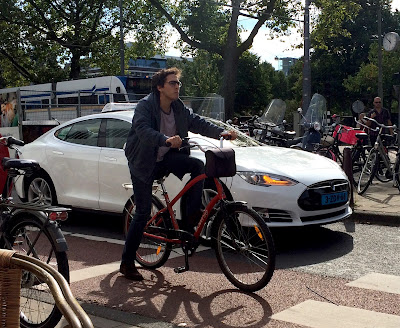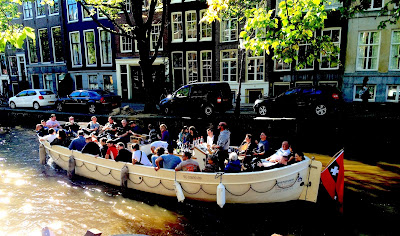September 3, 2015
Well here we are again in Europe for a month because it's still fun and it makes us feel alive. This time we chose Amsterdam because there are no hills here (in fact one fifth of the country is below sea level), because we found an apartment with an elevator, and because it is just one plane ride from Minnesota. We've been here before -- it was our first European destination in 1973 -- but never for long. We're due for a closer look.
Our apartment, with big sunny windows south and west, is in a newer 15-story hi-rise just outside the busy tourist center and aside the Heineken brewery .. two bedrooms, 1170 square feet, washer, dryer, dishwasher, big fridge, giant TV, fast internet .. all spotlessly clean. The trams below our windows are a bit noisy but oh so convenient.
A reminder .. you can click on any photo in this blog to see it bigger. (Nearly all were taken with our iPhone 5s.) Click on any of the few red links to go to an informative website.
Well here we are again in Europe for a month because it's still fun and it makes us feel alive. This time we chose Amsterdam because there are no hills here (in fact one fifth of the country is below sea level), because we found an apartment with an elevator, and because it is just one plane ride from Minnesota. We've been here before -- it was our first European destination in 1973 -- but never for long. We're due for a closer look.
Our apartment, with big sunny windows south and west, is in a newer 15-story hi-rise just outside the busy tourist center and aside the Heineken brewery .. two bedrooms, 1170 square feet, washer, dryer, dishwasher, big fridge, giant TV, fast internet .. all spotlessly clean. The trams below our windows are a bit noisy but oh so convenient.
A reminder .. you can click on any photo in this blog to see it bigger. (Nearly all were taken with our iPhone 5s.) Click on any of the few red links to go to an informative website.
Our gentrifying neighborhood is full of young folks, probably up-and-coming professionals, few of them even half our age. It seems safe and, because there are so few cars on the street, quite quiet. That's perhaps because more than half of the locals silently ride a bike to work. Most of them apparently go right past our door and to this nearby intersection. Click and watch out for the tram!
People seem respectful and unpretentious, the shops are varied and interesting if a bit worn, Holland's biggest street market is nearby and a half a mile long but a bit tacky, and the coffee is beautiful but all espresso-based and (by American standards) in small cups. Here's a cappuccino and, always in a glass, a latte.
But it’s easy to live here because, as a tour guide told us, “we’re all born speaking two languages, Dutch and English.” And their English is even colloquial .. one waitress greeted us with “Hi there, you guys.” How lucky for us is that?
We’re told that the Netherlands (nickname Holland) is the most densely populated country in Europe, has the most museums (over 1000) and also the tallest citizens. The average male is 6’1” and many women are also taller than me ("it's because we feed our children such good food," one woman told me). Even the mannequins in the street market are giant-size:
Since it was a colonial power in the 17th century, Holland has long welcomed people from all over the world; today it is home to some 180 nationalities. So at first glance, Amsterdam seems a modern, tolerant, vital city full of tall young people, some 34.9% of whom are "non-Western foreigners," whatever that means.
But it’s easy to live here because, as a tour guide told us, “we’re all born speaking two languages, Dutch and English.” And their English is even colloquial .. one waitress greeted us with “Hi there, you guys.” How lucky for us is that?
We’re told that the Netherlands (nickname Holland) is the most densely populated country in Europe, has the most museums (over 1000) and also the tallest citizens. The average male is 6’1” and many women are also taller than me ("it's because we feed our children such good food," one woman told me). Even the mannequins in the street market are giant-size:
Unlike in Paris, our neighbors don’t seem at all fashion-focused or pretentious. There’s a supermarket and a fine Indian restaurant below us, dozens of other restaurants nearby (including McDonalds and Starbucks), and that huge street market down the block. The first day we had so much fun there .. flowers, fresh fruit, cheeses, veggies and greens, fish and meat, bakeries, street food, new and used clothing, shoes, housewares and, yes, tee-shirts and wooden tulips for the tourists.
Next morning in misty rain we made our first trek to the center. When we got on the tram three young people offered us their seats, but when we came home (dead tired) nobody did. Bummer. The main square was busy and there were long lines at Madam Tussauds and at the Amsterdam Dungeon (whatever that is). Can we skip those?? Since then, the tram has rarely been crowded because another one seems to arrive every 3-4 minutes.
Traveling independently requires some coping but that’s part of the fun: getting in from the airport, figuring out the transit system, locating ATMs, shopping for items with foreign names, reading maps and apps, watching the weather, avoiding the bike lanes, finding coffee, etc. As in all of our European visits we feel safe here, and the Dutch seem more pleasant and helpful than most.
We sleep as late as we want and then go out for coffee, lunch and exploring. It seems we're always at a canal:
And sometimes looking in on people living in one of the 2500 houseboats, all connected to city water and sewer. Several were available as furnished vacation rentals for the month of September but all were located too far out.
We're too old to be in a different hotel every night, so for the twelfth time we're renting a European apartment for an entire month or more. If we wish we can return home for a mid-afternoon nap or stay home on a rainy day, whatever. We can only pretend we belong here, of course. But we do get a pretty good feel for a place.
So far we do like it here and are glad we came to Amsterdam.







































































